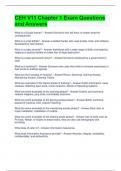CEH V11 Chapter 1 Exam Questions
and Answers
What is a suicide hacker? - Answer-Someone who will hack no matter what the
consequences.
What is a script kiddie? - Answer-unskilled hacker who uses scripts, tools, and software
developed by real hackers.
What is a cyber terrorist? - Answer-Individuals with a wide range of skills, motivated by
religious or political beliefs to create fear of large destruction
What is a state sponsored hacker? - Answer-Someone employed by a government to
hack
What is a hacktivist? - Answer-Someone who uses their skills to increase awareness of
their social or political agenda.
What are the 5 phases of hacking? - Answer-Recon, Scanning, Gaining Access,
Maintaining Access, Clearing Tracks
What are examples of the Recon phase of hacking? - Answer-Public information, news
releases, detecting open ports, router locations, details of Operating systems,
What are some examples of the scanning phase? - Answer-Dialers, port scanners,
network mappers, ping tools, vulnerability scanners,
What are some examples of the gaining access phase? - Answer-Buffer overflows,
password cracking, DoS, session hijacking
What are some examples of the maintaining access phase? - Answer-Back door or
trojan installation. Installation of rootkits.
What are some examples of the clearing tracks phase? - Answer-Use of tools such as
PsTools, Netcat, or trojans to erase tracks, they can also use stenography and
tunneling.
What does IA refer to? - Answer-Information Assurance.
What does Information Assurance provide? - Answer-Assures: Integrity, availability,
confidentiality, and authenticity.
, What is defense in depth? - Answer-Strategy that security professionals use to provide
several layers of protection through the whole system.
What is Risk? - Answer-Degree of uncertainty or expectation of damage that an adverse
event could cause.
Risk = - Answer-Threats x Vulnerabilities, X Impact
Level of Risk = - Answer-Consequence x Likelihood
What are the four primary levels of risk? - Answer-Extreme, High, Medium, or Low
Authenticity - Answer-Characteristic of communications, data, messages that ensures
the quality of being genuine or uncorrupted.
Confidentiality - Answer-Assurance that the information is accessible only to authorized
individuals.
Integrity - Answer-Trustworthiness of data, protection against unauthorized changes.
Ensures data accuracy.
Non-Repudiation - Answer-Way to guarantee the sender or receiver of a message
cannot deny it later.
Attacks = - Answer-motive (goal) + method + vulnerability
Passive Attack - Answer-Monitoring network traffic and data flow on the target but not
tampering with the data.
Examples of Passive Attacks - Answer-Footprinting, Sniffing, Eavesdropping, Network
Traffic Analysis, Decryption of weakly encrypted traffic.
Active Attack - Answer-Tamper with the data in transit or disrupt communication or
services between systems to bypass or break into security systems
Examples of Active Attacks - Answer-DoS (Denial of Service), Modification of
information, spoofing, replay attacks, by-passing protection mechanisms, malware
attacks, privilege escalation, backdoors, sql injection, dns and arp poisoning, session
hijacking, more.
Close in Attacks - Answer-Close proximity with the target system or network.
Example of Close-In Attacks - Answer-Social Engineering: Eavesdropping, shoulder
surfing, dumpster diving, and others




